| 1 | Indian krait |
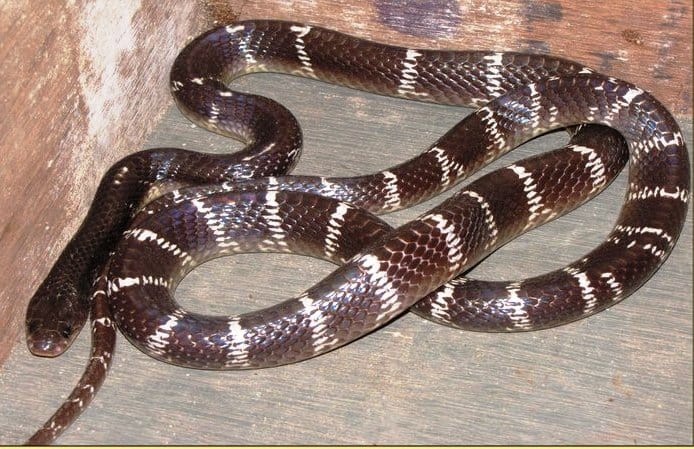
One of the deadliest snakes in the world. The Indian krait (Bungarus caeruleus) causes an estimated 15-30% of snakebites in India, 28% in Bangladesh, and 70-80% of untreated bites are fatal. This is part of the “big 4” of dangerous Indian snakes, also including the saw-scaled viper, Indian cobra, and Russell’s viper.
Bungarus caeruleus measures 90-110cm (record 165cm) and manifests in a variety of locations, from fields to agricultural areas to woodlands to villages. It eats a varied diet, but is particularly biased towards snakes, with confirmed meals including Whitaker’s sand boa and Brahminy’s blind snake.
Bungarus caeruleus inhabits every region of India, as well as Sri Lanka. Its venom is strongly neurotoxic, containing both pre and post-synaptic neurotoxins, preventing brain signals from being issued, and from binding to receptors in muscle cells.
The Indian krait is most disturbing for its completely painless bites, and lack of any local symptoms. Many victims are bitten while sleeping, and have no idea what happened. This medical report followed an Indian army soldier on an exercise patrol in a forest, where he slept the night in a sleeping bag. The next day, all the muscles over his body were aching, and his head was pounding. He visited hospital, where his facial muscles were now stiff, his saliva was pooling inside his mouth, and he struggled to swallow.
The doctors could find no bite mark anywhere, nor bleeding, and gave him 10 vials of combined cobra, krait and viper antivenom. The man recovered, and based on the symptoms, it was assumed to have been a Bungarus caeruleus bite, but never confirmed.
| 2 | Malaysian blue krait |
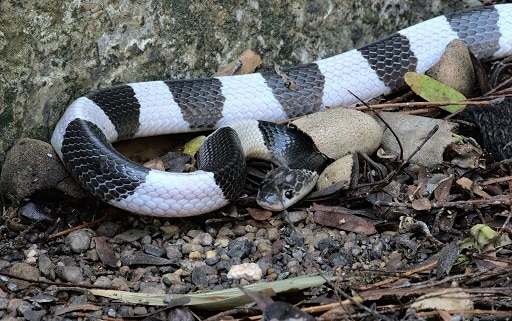
A common species of southeast Asia. The Malaysian blue krait (Bungarus candidus) inhabits most of Thailand, Vietnam, Cambodia, and peninsular Malaysia, and stretches southwards all the way to Java. Their habitats include deciduous and evergreen forests, and leafy villages on their outskirts. Like other Bungarus members, they’re active at night and sluggish by day.
This species is slightly weaker than its Indian cousin, at an LD50 rating of 0.1mg versus 0.09mg for Bungarus caeruleus. Yet this is only splitting hairs. The fact is that a Malaysian blue krait has a 70-80% chance of killing you without swift antivenom treatment.
Bungarus candidus is rich in the bungarotoxins (neurotoxins) possessed by most of its family. It also has a unique toxin called candotoxin. The blue krait may be one of the deadliest, as a 2018 study analysed 78 confirmed krait victims from a Bangkok hospital. Three species were responsible for bites: blue kraits, banded kraits (Bungarus fasciatus) and red headed kraits (Bungarus flaviceps). 6 patients of the 78 died, and all were victims of the blue krait. This was despite every patient receiving antivenom.
The earliest symptoms include trouble swallowing and drooping eyelids (ptosis). Full body paralysis is normal, and artificial ventilation is a typical result. Luckily, Bungarus krait antivenom is well stocked in every Thai hospital. This species measures 100-150cm, with a record of 155cm.
| 3 | Banded krait |
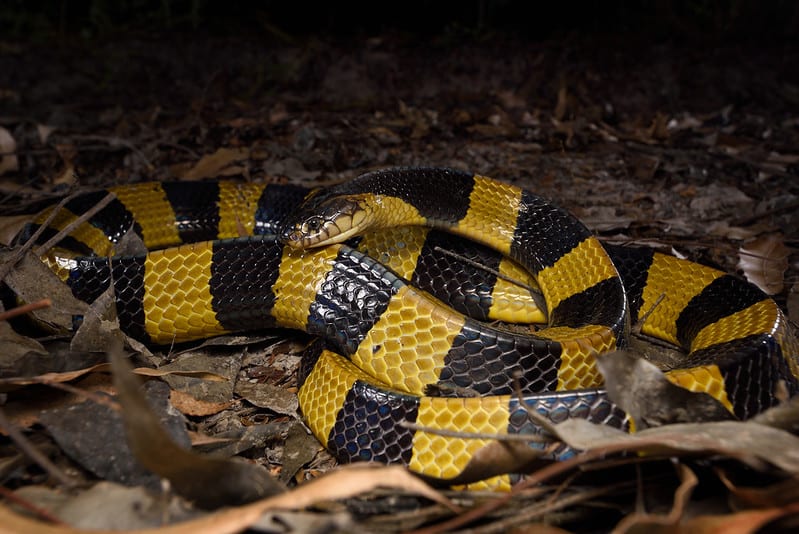
An easily recognisable species, with its bright yellow bands, compared to white for most members of the Bungarus genus. Banded kraits (Bungarus fasciatus) are one of the longer kraits, with a confirmed record so far of 212.5cm. The average is 120-150cm, and each yellow and black band is roughly equal in width.
Banded kraits have an LD50 rating of 1.2mg, making them slightly less fatal than blue kraits. Yet their venom still injects a multitude of neurotoxins in only a fraction of a second, unleashing dizziness, vomiting, abdominal pain and respiratory failure.
Banded kraits are extremely widespread, and live alongside Malaysian blue kraits in most of their range. Their realms are similar, including Thailand, Cambodia, Vietnam, and peninsular Malaysia. However, the banded krait spreads further westwards, reaching eastern India, and further eastwards along the Chinese coast, reaching Hong Kong.
Habitats of the banded krait include woodland and agricultural areas, normally near water sources, at altitudes of up to 2300 metres. Its likely that there’s subtle habitat differences to the blue krait which haven’t been discovered yet, allowing the two species to coexist in Thailand.
Bungarus fasciatus has a very flexible diet. Mammals, rodents and fellow snakes are all on the menu, including common wolf snakes and oriental ratsnakes. One captive banded krait even gobbled down a sausage.
| 4 | Greater black krait |
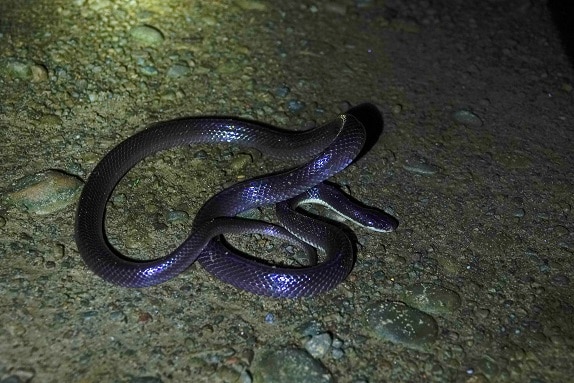
One of the less common Bungarus members. Black kraits (Bungarus niger) live in northeast India, Bhutan and Bangladesh, and look like they were generated by the night itself. A lack of yellow-white bands is their signature feature, with a fully black body contrasting against a paler belly.
The greater black krait was originally discovered in 1908, in the Darjeeling District of West Bengal. This is a shorter species, reaching a maximum of 120cm. Black kraits are a heavily nocturnal species, and are most commonly encountered from 18:00-02:00. Their habitats include evergreen forest, plantations, open grassland and villages.
Being nocturnal, and almost fully black, this krait can be very difficult to spot, especially on a cloudless night. This species is equally as nasty as its cousins, as shown by a study on 5 proven bite victims in Bangladesh. One victim suffered paralysis, and later kidney failure, which proved fatal. He also experienced rhabdomyolysis – when the destruction of muscle tissue leads to an increase in creatine kinase, a bloodstream biomarker of muscle damage.
Another patient experienced paralysis, to which he succumbed. Another 3 paralysis patients recovered, including one who was placed on artificial ventilation.
Confirmed prey include radiated ratsnakes, mizo rain snakes and common mock vipers. Black kraits can also eat venomous snakes, as in captivity, one swallowed a juvenile red-tailed bamboo pitviper (Trimeresurus erythrurus).
| 5 | Andaman krait |
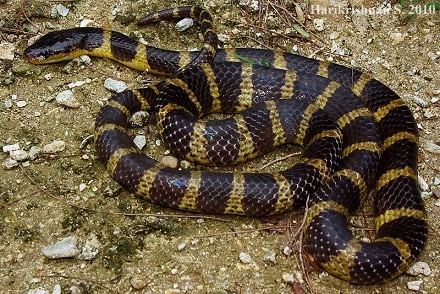
The resident terror of India’s Andaman and Nicobar Islands. These islands are located closer to Thailand than India, yet are officially part of the latter.
The Andaman krait (Bungarus andamanensis) is common in rice paddy fields, and on roads at night, particularly after heavy rains. They can be found within forests in mountainous areas as well as near coasts, and have occasionally been spotted inside termite mounds. This species averages at 90cm, with a maximum length of 130cm.
Bungarus andamanensis is one of the least researched kraits. Virtually nothing is known about its venom, through researchers have witnessed its defensive style. A scared Andaman krait will coil itself up and hide its head, remain still, and produce a strange squeaking sound.
Like the banded krait, Andaman kraits have yellow bands instead of white, but this time, the yellow is far thinner than the black, rather than equal in width. There are no other kraits on the Andaman and Nicobar Islands, making this species very easy to recognise. Its diet is poorly researched, but some individuals have been spotted swallowing water snakes, in the shallow streams they tend to live near.
| 6 | Northeastern hill krait |
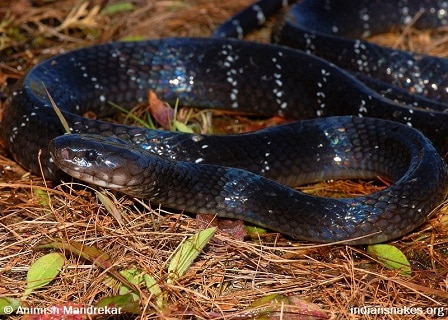
A rarely observed species which lives far from towns and cities. The northeastern hill krait (Bungarus bungaroides) is found in southeast Tibet, northeast India, eastern Nepal and Bhutan. It reaches a known maximum of 145cm, but is one of the most poorly researched members overall.
Bungarus bungaroides is a purely black and white species, with extremely thin white bands, sometimes so thin that its patterns resemble a starry night. This species is found in submontane forests on the foothills of the Himalaya, up to altitudes of 2400 metres, and as low as 250 metres.
Virtually no studies exist on this species, whether on its ecology or diet. Its venom contains the lethal post and pre-synaptic neurotoxins of other kraits, but its disposition is reportedly milder. The northeastern hill krait is apparently reluctant to bite, even when persistantly povoked. When spooked, they prefer to coil loosely and hide their head and brain instead.
As the picture above shows, this species has a clear iridescent sheen. Though mainly a ground-dwelling snake, northeastern hill kraits will sometimes climb small shrubby branches, possibly to analyse hidden animal scents. Overall, this species remains one of the snake kingdom’s minor mysteries.
| 7 | Sind krait |
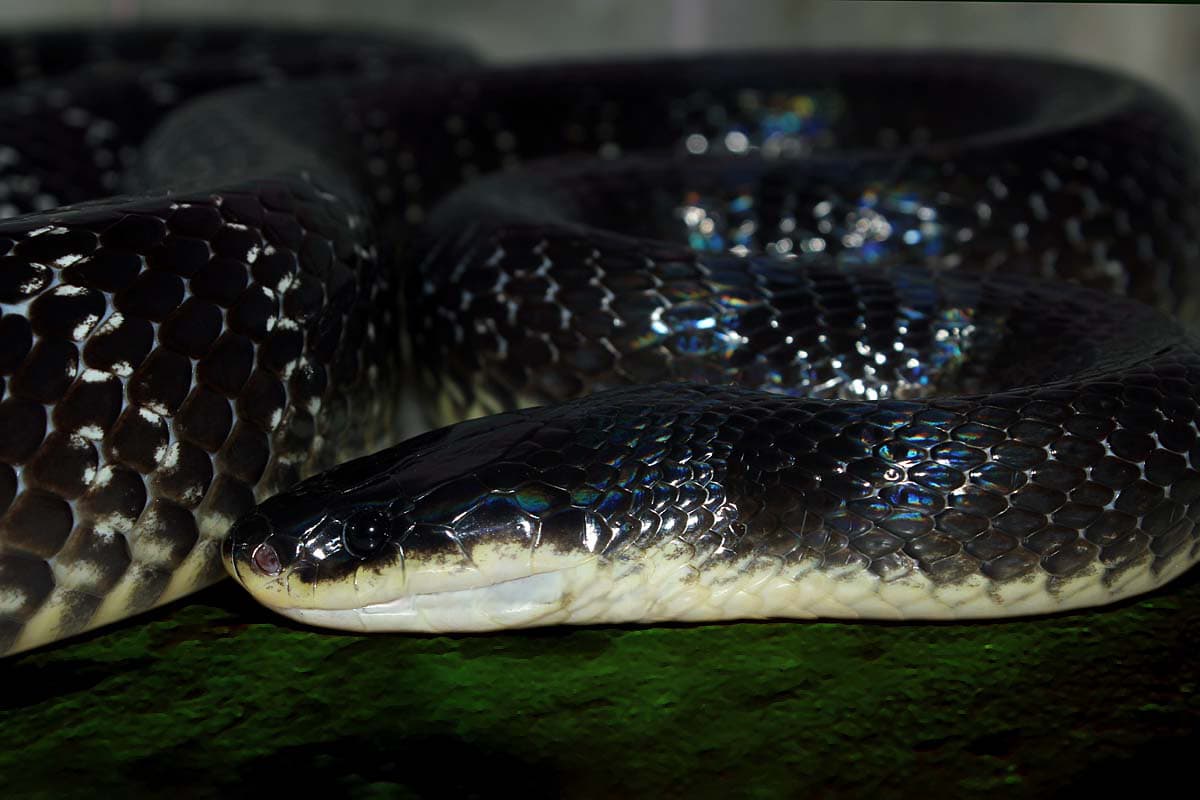
The Sind krait (Bungarus sindanus) lives in northwest India, Pakistan and Afghanistan, and is often confused with the Indian krait, which it overlaps with in parts of India. The two have a close resemblance, with only subtle differences, including 17 dorsal scale rows in the Sind krait versus 15 in the Indian. Sind kraits measure 100cm, with a maximum of 180cm, and are just as deadly as the Indian krait, though less common.
An analysis of Bungarus sindanus venom revealed 36 distinct proteins from 8 separate toxin families. Its venom mainly contained three-finger toxins and phospholipase A2s, and was extremely lethal when injected into mice.
This species lacks a dedicated antivenom. Instead, scientists gave the mice Indian VINS Polyvalent Antivenom, the elixir found in most hospitals, produced using each member of the big 4, including Indian kraits. This disabled some of the Sind krait toxins, saving the mice from death. However, the recovery times were long.
As usual, this species is active at night. Two proven bites happened to construction workers in Pune District, Maharashtra State, India, both of whom were sleeping in makeshift huts at night. One victim developed neuromuscular paralysis, and abdominal pain, and was only discharged from hospital following 6 days of artificial ventilation. The Sind krait also has a subspecies: Bungarus sindanus razai, found only in northern Pakistan.
| 8 | Red-headed krait |
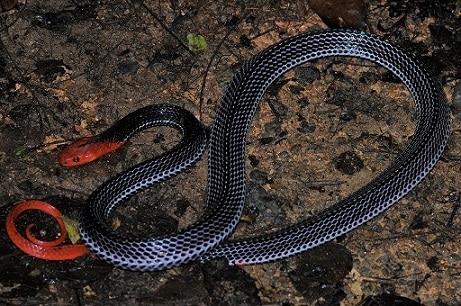
One of the most southerly krait species. Red-headed kraits (Bungarus flaviceps) begin in southern Thailand, and cover most of Malaysia as well as Singapore, Java and Sumatra.
Despite their large range, this species is sighted much more rarely than its cousins, and causes fewer bites. Bungarus flaviceps lives mainly in densely forested lowlands and humid premontane forests, below 900 metres in altitude. They’re found near forest streams and pools, and invade homes far less commonly than their relatives.
The red-headed krait possesses a neurotoxic venom, consisting of 56.2% beta-bungarotoxin, a form also found in many-banded kraits. This is a pre-synaptic neurotoxin, which are significantly hard to treat than post-synaptic neurotoxins, as they disrupt the very creation of neurological signals.
Another 12.85% of their venom consists of metalloproteinases, which physically dissolve proteins, such as those in blood vessels. This species also has no dedicated antivenom. A 2022 study found that blue krait antivenom was significantly more effective against the red-headed krait than banded krait antivenom, so it’s likely that those two have a greater toxin overlap.
Red-headed kraits average at 100-120cm, with an alltime record of 195.5cm. This is a distant offshoot within the Bungarus krait genus, splitting off before most other members. The red head is a simple way to identify Bungarus flaviceps, but not always, as there’s several mimics in southeast Asia, most famously the pink-headed reed snake.
| 9 | Suzhen’s krait |

A new species, which was finally made official in 2015. Suhzen’s krait (Bungarus suzhenae) was originally encountered by herpetologists in 2001, but assumed to be a many-banded krait instead. This initial grisly encounter happened to famous herpetologist Joseph Slowinski, who was bitten in Myanmar while handling the snake, and died 29 hours later. Nobody realised that it was a new species, until a detailed analysis in 2015 revealed subtle differences.
Firstly, Bungarus suzhenae had fangs which were only slightly curved backwards, versus noticeably curved for the many-banded krait. The shape of the patterns was unique, as the white bands were messier, less orderly. Bungarus suzhenae also had a completely pale belly, while many-banded kraits have a pale belly scattered with brown markings. Finally, the maximillia teeth were differently shaped.
The two species were finally separated, with Bungarus suzhenae now inhabiting northern Myanmar and southwestern China, including Yunnan province. This is a snake of rice fields and forested streams, at elevations of 800 to 1560 metres.
Its wild diet is still completely unknown, but there are clues from captivity, where a Suzhen’s krait happily accepted an Asian swamp eel and yellow-spotted keelback watersnake, while refusing mice and frogs. This species seems average in length for the Bungarus krait genus, as one of the original individuals discovered measured 114cm.
| 10 | Many-banded krait |

The most easterly Bungarus krait member, as well as the deadliest member, as measured by drop for drop venom potency. The many-banded krait (Bungarus multicinctus) has a nightmarish LD50 rating of 0.07mg, and is saved only by a weak venom yield of just 7mg per bite.
This species has small pockets of territory in Thailand, but is most common along the southern Chinese coast. They’re especially common in Hong Kong and Taiwan, where they’re statistically one of the top venomous snakes, which all citizens are instructed to avoid from a young age.
This species measures up to 150cm, possibly 180cm. While their colouring is similar to other members, the clue is in the name – the many-banded krait (Bungarus multicinctus) is distinguished by its thinner bands, and unusually higher number of bands, at 42-60.
Over 50% of its venom consists of beta-bungarotoxins, a potent presynaptic neurotoxin. Another large chunk are alpha-neurotoxins, which are post-synaptic neurotoxins, meaning that many-banded kraits possess the complete neurotoxic package. Early symptoms include nausea, vomiting, dilated pupils and intense muscle aches. A 2017 study from Taiwan found that 27% of patients developed respiratory failure within 1.5-6.5 hours.
As usual, this is a nocturnal species. If you walk past a dozing many-banded krait during daylight, they’ll likely barely react, sometimes not budging even if touched (which we don’t recommend in any circumstances). When night falls, they become alert and focussed, and will respond viciously to anybody invading their personal space.
Beware the many-banded krait’s neck, as it can bend at extreme angles, which makes picking one up extremely unwise.
